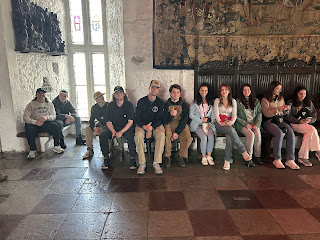On June 1st, we boarded Viking Mike’s modern longship after visiting Athlone Castle,
and we proceeded to make our way down the River Shannon. Shortly after boarding the
boat, we found out first-hand the workings of one of Ireland’s “canal locks”. These
structures are meant to change the water elevation for boaters in the canal. In our situation,
we were coming from a higher part of the canal, to match the water level of the River
Shannon, hydraulic arms opened and closed the gates of the lock. When ready, the water
is drained and the boat lowers. It was an interesting experience, just like riding a water
elevator. I have never experienced a mechanism like this firsthand, although its purpose
was explained on our first day in Ireland by Professor McCabe. Being able to witness
the method for allowing native boaters to navigate the Shannon was a good insight on
part of the day-to-day life of the people of Galway.
After getting through the canal’s locking system, we proceeded to move down the Shannon
on our way to the nearby monastic site, Clonmacnoise. The banks of the Shannon were lush with
vegetation, livestock, and a number of bird species. Seeing the Shannon serve as a natural fence
for horses and cattle gave the livestock fields a more open and almost “free-range” feeling. Cows
would graze all around their pastures up to the river, horses would chase after each other in their
open fields. While I’ve seen cows grazing before, I have never seen them doing so with as much
freedom as they have along the Shannon. Small electric fences kept several groups of fifteen to
twenty-five of the largest cows I have ever seen, and each one that I saw seemed happier than the
last. Too content to do anything else besides graze by the riverside.
The trip down the river also allowed us to see new species of birds in a new habitat. The
river provided a perfect environment for Mute Swans (Cygnus olor), Mallards (Anas platyrhynchos),
and Grey Herons (Ardea cinerea), to name a few. One of my favorite things to do in my free time,
ever since taking the Biology of Birds class with Professor Constantino in the Spring, is increasing
my “life list” by adding new birds that I record on Merlin and eBird. Doing so measures how many
different species of birds I have seen in my lifetime using these birding apps. Prior to the trip, I had
around 96 different species, and at this point in the trip, I have 129 different species. The River
Shannon helped me secure some rare birds to this list, which just made the river voyage all the better.
The group was lucky enough to spot a White-tailed Eagle (Haliaeetus albicilla) and with Constantino’s
help identifying this species previously, I was able to determine a European Shag (Phalacrocorax
aristotelis) from their “cousins” the abundant Great Cormorant (Phalacrocorax carbo). When it
comes to a species like the White-tailed Eagle, they are not native to North America, and even if they
are native to this region, they are still uncommon among birders. Being lucky enough to see a
magnificent bird of prey like this was very important to me because I do not believe I will see one
again. In my experience, a confirmed rare bird species sighting is a special occurrence that I always
look forward to.
While the cruise was taking place, Professor Constantino tasked a select few with data
collection on this river cruise. They were to record the species spotted in eBird to later transfer
the collected information to the class spreadsheet, which lists the different species, their
location, habitat, and the number of individuals in the different species. This assignment makes
up our Ireland Bird Survey assignment. So, as I was looking for birds for my personal interest,
I also did my best to help my group members with their data collection when asked. I would
also let them know some tips and tricks with the birding software and identification techniques,
as well as helping them confirm their sightings with my limited knowledge of the species that
make up the Irish-native birds that were present. Professor Constantino would do this for me
while taking the previously mentioned class, and continues to pull me aside whenever he sees
something new. I try to pay these actions forward by helping out my peers.
The Viking Boat continued to its final destination of the monastery of Clonmacnoise. This
gave the feeling of belonging to one of the Viking raids and later the Norman invasion of the
nation of Ireland. I am an avid history fan, and one of my favorite times in history is that of
the Viking/Norman activity in Ireland, Scotland, and England, which took place approximately
793-1066. Seeing the stone buildings and other masonry from the riverside would add to this
vision and give me an experience that I will not forget. After we finished the tour on the river,
we explored the monastery before returning to Galway with the help of the Viking Tour shuttles.
Quite an exciting and worthwhile day indeed.









